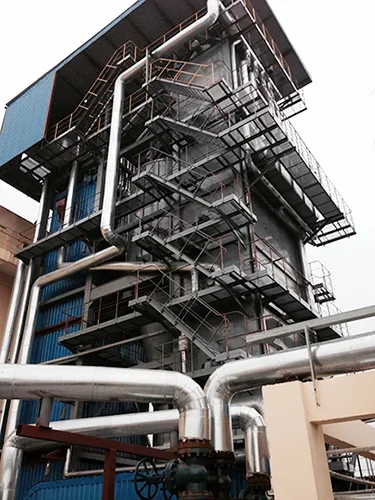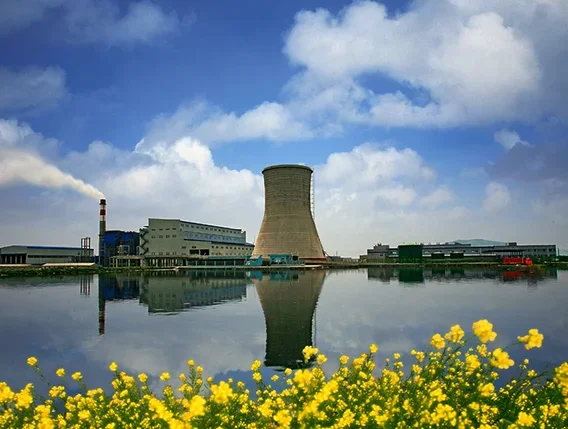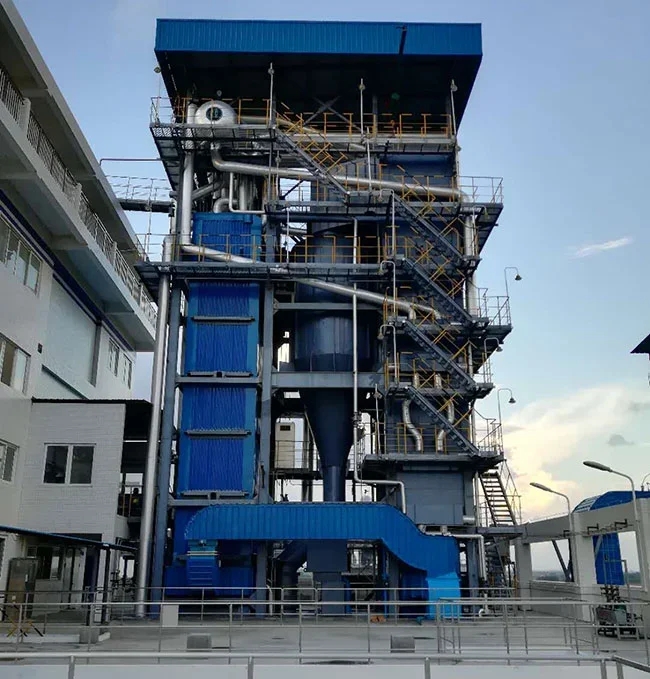Exploring the world of energy production unveils a key player: the circulating fluidized bed boiler. This innovative technology revolutionizes how power plants generate electricity efficiently and sustainably. By harnessing the power of circulating fluidized beds, these boilers offer enhanced combustion efficiency, reduced emissions, and flexibility in fuel choices. Understanding the intricate workings of circulating fluidized bed boilers is crucial for grasping their impact on the energy sector's future landscape. Stay tuned to delve into the inner workings, benefits, and applications of circulating fluidized bed boilers in this insightful exploration.
Understanding Fluidization Regimes
Minimum Fluidization
Fluidized bed boilers operate under different fluidization regimes based on factors like minimum fluidization, gas velocities, and solids fluxes.
Minimum fluidization refers to the minimum gas velocity required to keep solid particles suspended in a fluidized state.
Optimal Combustion Efficiency
Achieving the right fluidization regime is crucial for optimizing combustion efficiency in circulating fluidized bed (CFB) boilers.
The proper flow rate and gas velocity profile are essential for maintaining efficient heat transfer and reducing emissions.
Fuel Flexibility Impact
Different fluidization regimes influence a CFB boiler's ability to handle various fuel types, known as fuel flexibility.
Classifying Circulating Fluidized Bed Boilers
Bubbling vs. Circulating
Bubbling fluidized bed boilers have lower gas velocities, causing particles to move in a more random manner within the combustion chamber. Circulating fluidized bed boilers, on the other hand, operate at higher gas velocities, promoting better solid mixing and heat transfer.
Bubbling beds are ideal for small-scale applications, while circulating beds are suitable for large industrial processes due to their higher efficiency and capacity.
Key Characteristics
Circulating fluidized bed boilers feature a furnace where combustion occurs, utilizing solid fuels like biomass or lower-grade fuels efficiently. They employ a sorbent, such as limestone, to control emissions by capturing sulfur dioxide.
These boilers exhibit excellent combustion efficiency and offer enhanced flexibility in fuel choices. The design includes a loop seal that maintains proper solids circulation and a radial dispersion coefficient, ensuring uniform temperature distribution.
Advantages over Other Boiler Types
-
Superior Fuel Flexibility: CFB boilers can burn various fuels, including low-quality coal and biomass, with high efficiency.
-
Enhanced Combustion Efficiency: The circulating nature of the bed ensures thorough mixing of fuel and sorbent, leading to optimal combustion.
-
Lower Emissions: The use of sorbents helps capture pollutants like sulfur dioxide, reducing environmental impact.
-
Improved Heat Transfer: The turbulent conditions within the bed enhance heat transfer rates, boosting overall efficiency.
-
Scalability: CFB technology is easily scalable from small domestic units to large industrial applications.

Core Technology of CFB Boilers
Cyclone Separator
The cyclone separator in CFB boilers plays a crucial role in separating solid particles from the flue gas. It efficiently recycles unburned carbon and other particles back into the combustion chamber.
The high combustion temperatures within the cyclone separator ensure optimal combustion efficiency by promoting complete fuel burnout. This component significantly contributes to reducing harmful emissions while maximizing energy production.
Loop Seal
Within CFB boilers, the loop seal maintains a continuous flow of solids between the furnace and the cyclone separator. It prevents solid particles from escaping the combustion chamber, ensuring smooth operation.
By controlling the circulation of solids, the loop seal enhances heat transfer efficiency within the boiler system. This mechanism minimizes heat loss and optimizes overall performance, making it a vital element in CFB technology.
Primary and Secondary Air
In CFB boiler operation, primary air is responsible for fluidizing the bed of solids within the combustion chamber. It ensures proper mixing of fuel and sorbent materials, promoting efficient combustion reactions.
On the other hand, secondary air aids in combustion by providing additional oxygen to support the burning process. This controlled supply of air helps maintain optimal combustion temperatures and enhances heat transfer rates within the boiler.
Advantages of Using CFB Boilers
Environmental Benefits
Improved combustion in circulating fluidized bed (CFB) boilers leads to lower emissions compared to traditional boiler systems. The technology allows for efficient burning of various fuels, reducing harmful pollutants released into the atmosphere.
CFB boilers offer fuel flexibility, enabling the use of a wide range of materials such as biomass, coal, and waste fuels. This versatility contributes to environmental sustainability by promoting the utilization of renewable energy sources and reducing dependence on fossil fuels.
Efficiency and Reliability
The high efficiency of CFB technology ensures optimal heat transfer and combustion processes, resulting in enhanced performance and reduced energy wastage. This efficiency translates to lower operating costs and increased productivity for industrial applications.
CFB boilers are known for their reliability in operation, providing consistent heat generation with minimal downtime. The stable combustion process and effective control mechanisms contribute to the overall dependability of these systems, making them a preferred choice for continuous production processes.
Economic Advantages
The use of CFB boilers offers significant economic advantages, primarily through reduced operational costs and fuel savings. By achieving efficient combustion and heat transfer, these boilers optimize energy utilization, leading to cost-effective operations for industries and power plants.
Moreover, the ability to utilize a variety of fuels in CFB boilers results in financial benefits by enabling businesses to choose cost-effective fuel options based on availability and pricing. This flexibility helps in mitigating risks associated with fuel price fluctuations and ensures long-term cost savings for organizations.

Limitations of CFB Boilers
Scale and Application
The scale limitations of CFB technology can hinder its widespread adoption in large industrial settings. While CFB boilers excel in smaller applications, scaling up for higher capacities poses challenges in terms of efficiency and cost-effectiveness.
In certain industrial sectors where massive energy production is required, conventional boilers may be preferred over CFB technology due to their proven track record at larger scales. This limitation underscores the need for further research and development to enhance the scalability of CFB boilers.
Mitigation Strategies
Operators can employ various strategies to mitigate the limitations of CFB boilers and enhance their overall performance. One such approach involves optimizing fuel flexibility by fine-tuning combustion parameters to accommodate a wider range of fuels without compromising efficiency.
Implementing advanced control systems that monitor key operational parameters can help prevent issues like erosion and corrosion by enabling real-time adjustments based on system conditions. These systems also facilitate predictive maintenance, reducing downtime and enhancing overall reliability.
-
Pros:
-
Enhanced fuel flexibility
-
Potential for improved efficiency
-
Design and Operational Essentials
Material Selection
CFB boilers require materials that can withstand high temperatures and corrosive environments. Components like the furnace, cyclones, and heat exchangers are often made of special alloys to ensure durability and longevity.
Fluidization Control
Efficient fluidization is crucial for optimal CFB boiler performance. By adjusting parameters such as air velocity and solids circulation rate, operators can maintain the desired bed density and prevent issues like agglomeration.
Bed Temperature Control
Controlling bed temperature is essential to prevent ash sintering and ensure efficient combustion. Operators monitor and adjust parameters like fluidizing air temperature and fuel feed rates to maintain the ideal operating conditions.
Ash Handling
Proper ash handling is vital for maintaining clean operation and minimizing environmental impact. CFB boilers utilize systems like cyclones, bag filters, and electrostatic precipitators to efficiently separate and remove ash particles from the flue gas.
Maintenance Practices
Regular maintenance is key to prolonging the lifespan of CFB boilers and avoiding costly downtime. This includes activities such as inspections, cleaning, and replacement of worn-out components, ensuring smooth operation over time.
Monitoring Systems
Advanced monitoring systems help operators track key parameters in real-time for proactive maintenance and troubleshooting. These systems provide data on bed temperature, pressure differentials, and fluidization quality, enabling quick responses to any deviations.
Importance of Optimization
Optimizing CFB boiler operation leads to increased efficiency, reduced emissions, and lower operating costs. By fine-tuning parameters like fuel-to-air ratios and feed points, operators can achieve peak performance while meeting environmental regulations.
-
Proper material selection ensures durability.
-
Efficient fluidization control prevents operational issues.
-
Regular maintenance prolongs boiler lifespan.
-
Advanced monitoring systems enable proactive maintenance.
Applications of CFB Boilers
Industrial Steam
CFB boilers find extensive use in industrial steam generation due to their efficiency and flexibility. They excel in providing a reliable source of steam for various industrial processes. The ability of CFB boilers to handle a wide range of fuels, including coal combustion, makes them versatile in meeting the diverse steam requirements of industries.
Thermal Power Stations
Thermal power stations leverage CFB technology for electricity generation, offering high efficiency and reduced emissions. These power stations benefit from the superior fuel flexibility of CFB boilers, allowing them to utilize different fuel sources like coal combustion efficiently. The adaptability of CFB boilers to varying loads and fuel types makes them ideal for the dynamic needs of thermal power plants.
Biomass Sector
In the biomass sector, CFB boilers play a crucial role in converting biomass into energy through combustion processes. Their capability to burn a variety of biomass fuels with high efficiency makes them essential for sustainable energy production. CFB boilers contribute significantly to reducing greenhouse gas emissions by utilizing renewable biomass resources effectively.
Waste-to-Energy Industry
The waste-to-energy industry embraces CFB boilers for converting waste materials into valuable energy sources. By employing CFB technology, waste-to-energy plants can achieve efficient and environmentally friendly waste incineration processes. The use of CFB boilers in this sector helps in minimizing waste disposal while generating electricity sustainably.

Final Remarks
The exploration of circulating fluidized bed boilers has shed light on the various fluidization regimes, classification methods, core technology, advantages, limitations, design essentials, and applications associated with this innovative technology. Understanding these aspects is crucial for industries seeking efficient and environmentally friendly combustion solutions. While CFB boilers offer notable benefits such as fuel flexibility and reduced emissions, their operational complexities and high initial costs warrant careful consideration before implementation.
In conclusion, delving into the intricacies of circulating fluidized bed boilers unveils a realm of possibilities for enhancing energy production and sustainability. Industries must weigh the pros and cons outlined in this discourse to make informed decisions that align with their operational needs and environmental goals. Embracing the advancements in CFB boiler technology can pave the way for greener practices and heightened efficiency in the realm of combustion systems.
Frequently Asked Questions
What are the different fluidization regimes in circulating fluidized bed boilers?
In circulating fluidized bed boilers, the fluidization regimes include bubbling, turbulent, and fast fluidization. Each regime has distinct characteristics affecting heat transfer efficiency and particle behavior.
How are circulating fluidized bed boilers classified?
Circulating fluidized bed boilers are classified based on their combustion technology into subcritical, supercritical, and ultra-supercritical types. These classifications determine the operating pressure and temperature ranges of the boilers.
What is the core technology behind circulating fluidized bed (CFB) boilers?
The core technology of CFB boilers involves a circulating loop that suspends solid fuel particles in a high-velocity stream of combustion air. This promotes efficient mixing and combustion, enhancing fuel flexibility and reducing emissions.
What advantages do circulating fluidized bed (CFB) boilers offer over other boiler types?
CFB boilers provide advantages such as enhanced fuel flexibility, efficient sulfur capture due to limestone addition, lower emissions of pollutants like NOx and SOx, improved heat transfer efficiency, and reduced greenhouse gas emissions compared to conventional boilers.
What are the limitations of using circulating fluidized bed (CFB) boilers?
Limitations of CFB boilers include higher initial investment costs compared to conventional boilers, challenges in controlling bed temperature uniformity, potential erosion of heat exchange surfaces due to particle movement, and complex operational requirements for optimal performance.






